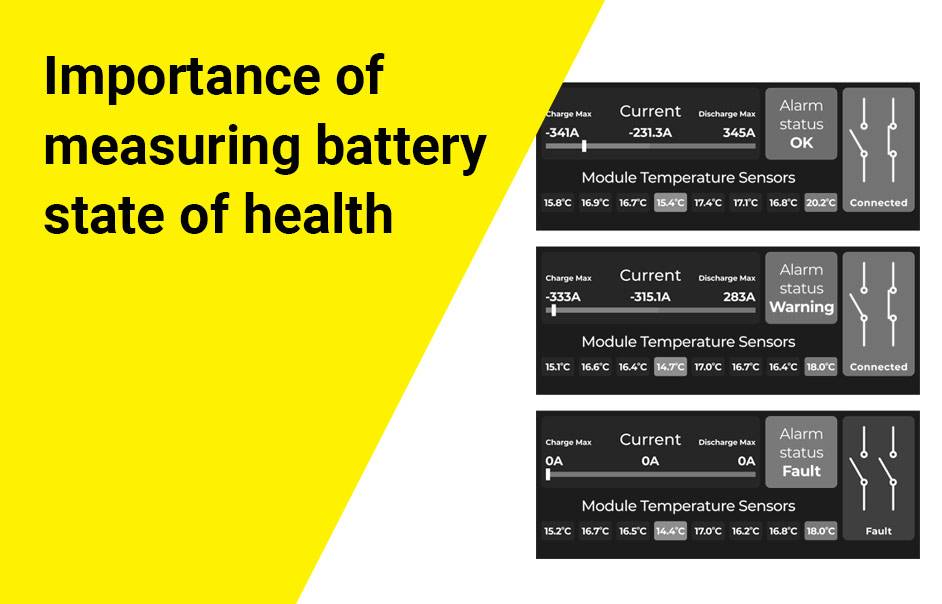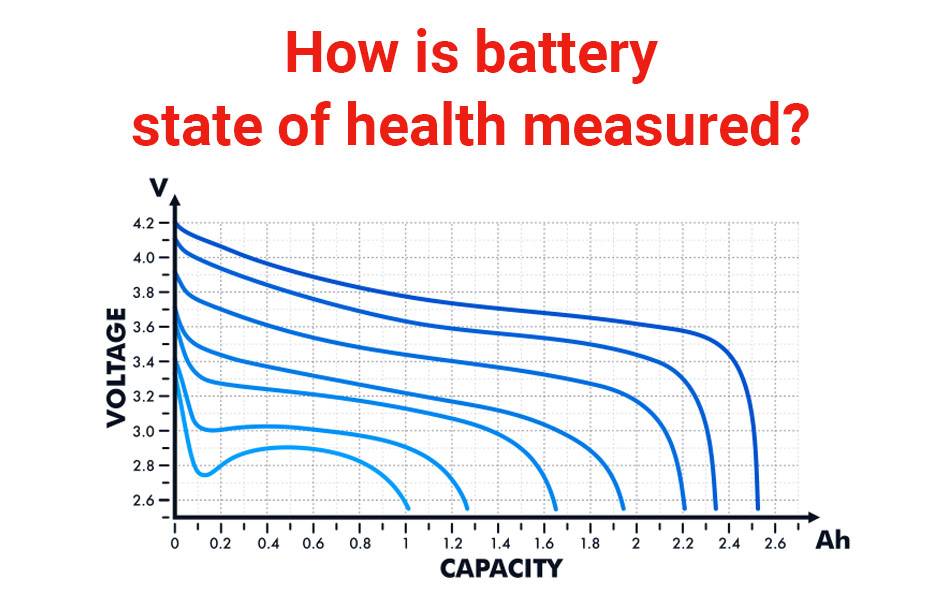Understanding the state of health (SoH) of batteries is crucial for their performance and lifespan, whether it’s for everyday devices or critical industries like automotive and renewable energy. SoH helps predict battery performance and prevent frustrating situations like dead smartphone batteries when you need them the most. In this blog post, we’ll explore methods to measure SoH, factors affecting these measurements, and how industries leverage this knowledge to enhance operations. Get ready to dive into the world of battery diagnostics!
Importance of measuring battery state of health
Understanding the health of batteries is critical in today’s world where they power essential devices like smartphones and electric vehicles. Let’s break down why measuring battery state of health matters:

- Optimizing Usage: Accurate measurements provide insights into factors like capacity degradation, helping us optimize battery usage and extend their lifespan.
- Safety Assurance: Monitoring battery health allows early detection of potential safety issues like thermal runaway, ensuring safe operation and preventing accidents.
- Industry Optimization: In sectors relying on batteries, such as renewable energy and electric transportation, measuring battery health optimizes system efficiency and ensures reliable power supply when needed.
Regularly measuring battery health offers numerous benefits, from safety enhancement to operational efficiency improvement. As technology progresses, more sophisticated methods for accurate assessments will likely emerge, leading to longer-lasting batteries with better performance.
Methods for measuring battery state of health:
Measuring battery state of health involves various methods to assess its condition and performance. Let’s explore these techniques:
- Voltage-Based Methods: Monitoring voltage output under different loads helps understand remaining capacity and degradation level over time. It’s a simple and cost-effective approach widely used for battery assessment.
- Resistance-Based Methods: Measuring internal resistance indicates potential issues like aging or damage, providing insights into overall health and anticipating future problems.
- Electrochemical Impedance Spectroscopy (EIS): This technique analyzes a battery’s response to electrical signals at varying frequencies, offering detailed information about its electrochemical processes and internal parameters.
Each method has its advantages and limitations, such as accuracy and complexity. Choosing the most suitable method depends on specific requirements and preferences.
A. Voltage-based methods
Voltage-based methods are commonly employed to assess the state of health (SOH) of batteries, offering valuable insights into their overall condition and performance. Let’s explore these techniques:
- Open Circuit Voltage (OCV) Measurement: This method involves measuring the battery’s voltage without any load or charging source. By comparing it to a reference value, we can estimate remaining capacity and battery health.
- Coulomb Counting: Coulomb counting calculates the charge flowing in and out of a battery over time, helping track changes in capacity and detect degradation in performance.
- Impedance Spectroscopy: This technique applies small perturbations to the battery’s terminals while measuring its response voltages at different frequencies. It provides insights into internal processes related to SOH, such as ion movement within the electrolyte and electrodes.
Voltage-based methods offer advantages like simplicity and non-invasiveness, but they may be less accurate in certain conditions. Despite limitations, they are widely used across industries to assess battery performance and optimize system designs.
B. Resistance-based methods
Resistance-based methods are commonly used to assess battery state of health (SoH), offering insights into its internal resistance and overall condition. Let’s explore these techniques:
- DC Internal Resistance Measurement: This method applies a small current to the battery and measures the resulting voltage drop, allowing estimation of internal resistance.
- AC Impedance Spectroscopy: By analyzing how alternating current passes through different frequencies, this method provides valuable information about charge transfer processes and electrode kinetics.
Resistance-based methods offer simplicity and cost-effectiveness, but they may not provide detailed insights into specific degradation mechanisms or early failure signs. Despite limitations, they remain valuable tools for assessing battery SoH and monitoring performance trends.
C. Electrochemical impedance spectroscopy (EIS)
Electrochemical impedance spectroscopy (EIS) is a sophisticated method for assessing battery health, offering detailed insights into internal electrochemical processes. Let’s delve into its key features:
- Detailed Analysis: EIS examines battery impedance at various frequencies, revealing behaviors like charge transfer resistance and electrode polarization.
- Subtle Performance Detection: It can detect subtle changes in battery performance, aiding in identifying degradation mechanisms and monitoring health over time.
- Challenges and Applications: While requiring specialized equipment and expertise, EIS finds applications in automotive, renewable energy, and consumer electronics industries, contributing to battery optimization and reliability.
Despite its challenges, EIS promises advancements in measurement accuracy and analysis algorithms, leading to more efficient energy storage solutions in the future.
Factors affecting battery state of health measurements
Various factors affect battery state of health measurements, influencing accuracy and reliability. Let’s explore these key factors:

- Temperature: Extreme temperatures, whether high or low, can significantly impact battery performance and capacity, affecting measurement accuracy.
- Battery Age: As batteries age, their capacity diminishes over time due to chemical reactions, impacting the accuracy of state-of-health measurements.
- Load: The load placed on a battery during testing affects its internal resistance and voltage drop, leading to potential inaccuracies in readings.
- Charging Cycles and Depth of Discharge: Frequent deep discharges or improper charging methods can accelerate wear and reduce overall battery lifespan, influencing performance measurements.
- Battery Chemistry: Different battery chemistries, like lithium-ion, require specific protocols for measurement due to their unique characteristics and sensitivity to overcharging or undercharging.
Considering these factors ensures accurate assessments and provides insights into how environmental conditions and usage patterns affect battery performance.
Advantages and limitations of different measurement methods
Different methods exist for measuring battery state of health, each with its own strengths and weaknesses. Let’s examine:
- Voltage-Based Methods: Simple and non-invasive, these methods measure battery voltage to assess health. However, they may lack accuracy with heavily degraded batteries.
- Resistance-Based Methods: These methods evaluate internal resistance, providing insights into overall battery condition and identifying high-resistance areas. Yet, they may not capture all degradation types.
- Electrochemical Impedance Spectroscopy (EIS): Advanced and detailed, EIS analyzes electrochemical processes. It can detect early degradation signs but requires specialized equipment and expertise.
Understanding these method’s advantages and limitations helps choose the most suitable one for specific applications.
Applications and industries using battery state of health measurements
Battery state of health measurements are increasingly crucial across industries worldwide, optimizing operations and enhancing efficiency. Let’s explore key sectors benefiting from these measurements:
- Electric Vehicles (EVs): Accurately assessing battery health ensures optimal performance and extends battery life in EVs, supporting timely maintenance or replacement.
- Renewable Energy: Solar power systems rely on battery health monitoring for storing excess energy efficiently, ensuring reliable operation even in limited sunlight conditions.
- Critical Industries: Sectors like telecommunications, aerospace, defense, and medical devices rely on reliable battery power, utilizing state-of-health measurements to detect early deterioration or capacity loss.
- Research and Academia: Battery health measurements aid in developing advanced battery technologies, improving performance for future applications.
Accurate measurements in these sectors maximize efficiency and minimize downtime, ensuring uninterrupted operations.
Future developments in battery state of health measurement technology
Future developments in battery state of health measurement technology promise significant advancements in accuracy and efficiency. Let’s explore what’s on the horizon:

- Advanced Data Analytics: Utilizing big data and machine learning algorithms can enhance battery health measurements by identifying patterns and anomalies in large datasets, leading to more accurate predictions.
- Non-invasive Sensing: Researchers are exploring non-invasive techniques for assessing battery health without physical contact or disassembly, simplifying the measurement process and reducing costs.
- Integrated Sensor Networks: Embedding sensors directly into batteries enables real-time monitoring of parameters like temperature, voltage, and impedance, providing continuous insights into battery health.
- IoT Connectivity: Integrating IoT technology allows for wireless monitoring of batteries, enabling remote access to real-time performance data from anywhere in the world.
- Nanotechnology Advancements: Nanotechnology offers miniaturized sensors with higher sensitivity levels, allowing for precise detection of changes within battery chemistry or structure.
These developments signify a bright future for battery health measurement technology, promising improved performance and longevity for batteries in various applications.

